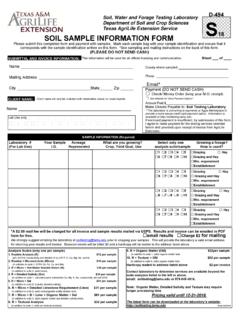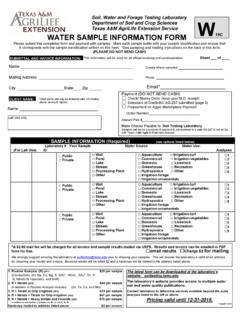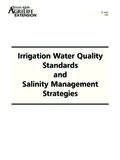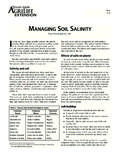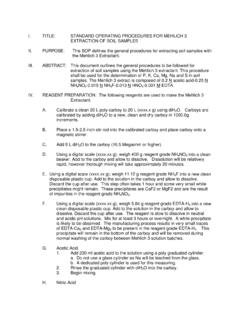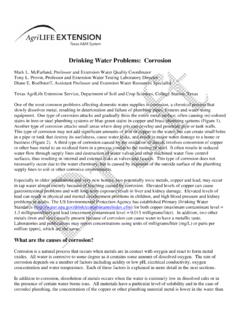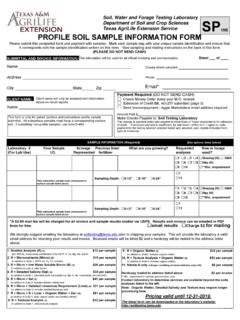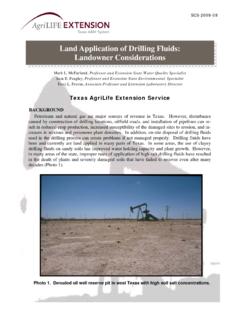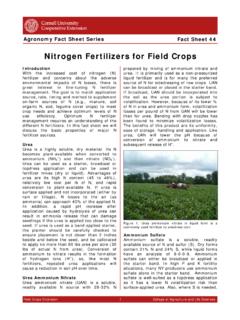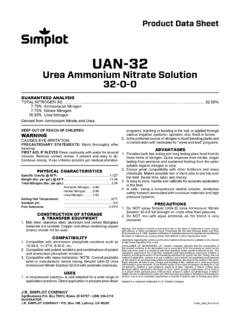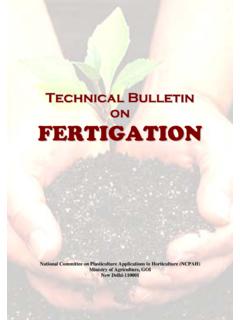Transcription of What Happens to Notrogen in Soils? - Texas A&M …
1 Efficient crop production requires an adequatesupply of all essential plant nutrients. However,the use of commercial nitrogen (N) fertilizers toincrease production, maintain profits and provide low-cost food and fiber is a necessity of modern agricul-ture. In general, crops need nitrogen in the greatestquantity of all plant environmental effect of nitrogen fertilizers hasbeen a long-term issue. Concern over nitrogen pollu-tion of rivers, lakes and groundwater has caused agri-cultural producers to become increasingly aware oftheir potential contribution to the total pollution effectively use nitrogen and to limit its adverseimpact on the environment, producers need to developan awareness of the chemistry of nitrogen and how itis added to and removed from the fertilizers used by agricultural produc-ers are a significant source of nitrogen addition tosoils.
2 nitrogen is continuously recycled through plantand animal waste residues and soil organic is removed from the soil by crops, gaseousloss, runoff, erosion and leaching. The magnitude andmechanism responsible for nitrogen losses dependupon the chemical and physical properties of a givensoil. Figure 1 is a schematic representation of the pos-sible gains and losses of soil of NitrogenNitrogen accounts for 79 percent of the air webreathe. The surface 6 inches of a fertile prairie soilmay contain 2 to 3 tons of nitrogen per acre. The airabove this same acre will contain about 35,000 tons ofinert nitrogen gas (N2). Most of the nitrogen found insoil originated as N2gas and nearly all the nitrogen inthe atmosphere is N2gas.
3 This inert nitrogen cannotbe used by the plant until it is changed to ammonium(NH4+) or nitrate (NO3-) important methods for changing nitrogen gas(N2) to ammonium (NH4+) are: Free-living N2-fixing bacteria N2-fixing bacteria in nodules on the roots of leguminous plants, and nitrogen fertilizer production important method of N2conversion isthrough lightning. When lightning flashes, the nitrogengas in super-heated air is converted to nitrate (NO3-)and nitrite (NO2-). Lightning may account for 1 to 50pounds of plant-available nitrogen per acre per year. Although nitrogen enters the soil in several chemi-cal forms, it eventually converts to the inorganicnitrate (NO3-) ion.
4 Figure 1 shows that NO3-can beused by plants, be converted back to nitrogen gas orbe leached downward with soil water. Commercial fertilizers, plant residues, animalmanures and sewage are the most common sources ofnitrogen addition to soils. Rates of application varywidely. Single application rates may be as high as 150E-596-01 what Happens to nitrogen in Soils? T. L. Provin and Hossner**Extension soil Chemist and Crop Sciences Professor; The TexasA&M University 1. The nitrogen cycle is a complex systeminvolving the air, soil and plant. pounds of nitrogen equivalent per acre for crops suchas coastal bermudagrass. However, such high applica-tion rates should be limited to soils with a low poten-tial for erosion and in organic materials (plant residues, ani-mal manures, sewage, soil organic matter) is present aspart of proteins, amino acids and other plant andmicrobial materials.
5 It becomes available to plantsonly after the compound is decomposed by soilmicroorganisms. This is called mineralization ( ). The first step of mineralization is ammonification. The ammonium (NH4+) derived from ammonificationis then converted to nitrate- nitrogen (NO3--N) by nitri-fying bacteria in the soil through the process called nitrification. Figure 2. The mineralization = Ammonification + NitrificationR* NH R*R* NH2NH4+NO-2NO3-R* = N R ammonium nitrite nitrateAmmonium NitrificationOrganic N to Inorganic NMineralizationR = Complex organic molecule, organic radicalThe locations of the ammonification and nitrifica-tion reactions in the nitrogen cycle are shown inFigure 1.
6 The positively charged ammonium (NH4+)ion produced by ammonification or added to the soilin fertilizers is attracted to negatively charged clay par-ticles in the soil . However, in most non-arid soils theNH4+ion is rapidly transformed to nitrate nitrogen (NO3-N) Growing plants absorb most of their nitrogenin the form of nitrate (NO3-).Common sources of inorganic nitrogen includeammonia (NH3), ammonium (NH4+), amine (NH2+)and nitrate (NO3-). Most fertilizer materials contain orwill form NH4+which is converted rapidly to NO3-once in the soil . Removal of nitrogen from SoilNitrogen is removed from soils by four majorprocesses: Plant uptake Gaseous loss Runoff and erosion LeachingPlant uptake refers to nitrogen absorption by , corn, tomatoes and turf grasses require 60 to300 pounds of nitrogen per acre to produce goodgrowth and profitable yields or desired aesthetics.
7 Theactual requirements for a given crop varies accordingto the production potential and are influenced greatlyby climatic factors. Because most soils are low in plant-available nitro-gen, the nitrogen requirements are often supplied ascommercial nitrogen fertilizer. nitrogen requirementsabove 150 pounds per acre generally are divided intotwo or more applications. However, only plant nitro-gen in the harvested crop actually leaves the field. Theremainder of plant nitrogen is returned to the soil asplant residue and reenters the cycle as organic nitro-gen as illustrated in Figure 1. Gaseous loss of nitrogen takes place by denitrifica-tion or ammonia volatilization.
8 Denitrification is aprocess through which nitrate nitrogen (NO3--N) isconverted to gaseous nitrogen oxide (N2O) or elemen-tal nitrogen (N2). This involved the action of anaerobicbacteria (those which do not require free oxygen) andcommonly occurs in wet or water-logged soils. NO3-NO2-N2O or N2 Nitrate Nitrite Nitrous oxides or GasNitrate to nitrite to nitrogen gasesSince this is an anaerobic process, gaseous lossesfrom a normal (aerobic) soil are small. However, whensoils stay very wet or saturated for long periods, alarge portion of the nitrate can be lost. Ammonia gas can evolve from nitrogen compoundssuch as urea on the surface of a soil .
9 Urea is presentin animal manure and may be purchased in pure formas a fertilizer (45-0-0).NH2CO + 2H2O H2CO3+ 2NH3NH2urea water carbonic ammoniaacid (volatilization)Other ammonium-containing fertilizer compounds,including ammonium sulfate (21-0-0) and, to a lesserextent, ammonium nitrate (33-0-0) and ammoniumphosphate, have been shown to produce free ammoniain the presence of calcium carbonate. This conditionexists in some high pH soils (pH> ).Runoff and erosion losses may include nitrate (NO3-), ammonium (NH4+), and organic nitrogen . Thenegatively charged NO3-ion remains in the soil waterand is not held by soil particles.
10 If water containingdissolved NO3-or NH4+runs off the surface, theseions move with it. However, when nitrogen fertilizersare applied to dry soils, and rain or irrigation water isapplied, the first water dissolves the fertilizer and car-ries it into the soil . Rainfall does not generally causesurface losses of fertilizer nitrogen , unless very inten-sive rainfall occurs shortly after held by clay particles can be carriedinto surface water supplies by soil erosion. In fact, soilerosion moves more nitrogen than does rainfall inmoving dissolved nitrogen compounds. When erosion-al soils are deposited in rivers and lakes, microbialactivity will slowly convert nitrogen compounds intosoluble losses involve the movement of waterdownward through a soil below the root zone.
